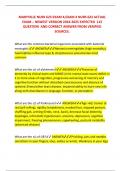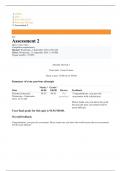MARYVILLE NURS 623 EXAM 4,EXAM 4 NURS 623 ACTUAL
EXAM .. NEWEST VERSION 2024-2025 EXPECTED 115
QUESTION AND CORRECT ANSWER FROM VERIFIED
SOURCES.
What are the common bacterial organisms associated with bacterial
meningitis.✔✔ ANSWER✔✔✔Neisseria meningitides (high mortality),
haemophilus influenza type B, streptococcus pneumoniae most
common
What are the s/s of alzheimers?✔✔ ANSWER✔✔✔Presence of
dementia by clinical exam and MMSE (mini-mental state exam) deficit in
2 or more areas of cognition, progressive worsening of memory and
cognitive function without disturbed consciousness and absence of
systemic illness/other brain disease. Impaired ability to learn new info
along with disturbance in language, function, or perception.
What are the s/s of Parkinsons?✔✔ ANSWER✔✔✔Age >60, tremor at
rest (pill rolling), rigidity, bradykinesia, masked face, stopped posture,
shuffling gait, arching (limbs, neck, back), decrease facial dexterity,
dysphagia, orthostatic hypotension, anosmia, depression, cognitive
impairment, freezing phenomenon, cogwheeling, postural instability
(advanced disease)
What are the s/s of GB?✔✔ ANSWER✔✔✔Prickling, pins and needles
sensations in your fingers, toes, ankles or wrists. Weakness in your legs
,that spreads to your upper body. Unsteady walking or inability to walk
or climb stairs. Difficulty with eye or facial movements, including
speaking, chewing or swallowing. Severe pain that may feel achy or
cramplike and may be worse at night. Difficulty with bladder control or
bowel function. Rapid heart rate. Low or high blood pressure. Difficulty
breathing.
What are s/s of temporal arteritis?✔✔ ANSWER✔✔✔Jaw claudication
(pain with chewing that is relieved when stops chewing), unilateral pain,
temporal area with scalp tenderness; skin over artery is indurated,
tender, warm, and reddened. Amaurosis fugaz (temporary blindness),
may occur. Low-grade fever and fatigue, occurs sometimes. ESR/sed rate
(often reaches 100 mm/hr or more). CRP elevated >50. Medical
Urgency: polymyalgia rheumatica common in these patients, older
adults and elder are more common.
What are articular bone structures?✔✔ ANSWER✔✔✔Includes
structures like the synovium, synovial fluid, articular cartilage, joint
capsules, and juxta-articular bone. Articular disorders may be
characterized by deep or diffuse pain, pain or limited ROM on active
and passive movement, swelling, crepitus.
What are non-articular bone structures?✔✔ ANSWER✔✔✔Supportive
structures such as tendons, bursae, muscles, fascia, bone, nerve,
overlying skin. Tend to be painful on active but not passive (assisted)
ROM. Seldom demonstrate swelling, crepitus, instability, or deformity
by itself.
, What dx test is most useful in patient who presents with lumbar
radiculopathy?✔✔ ANSWER✔✔✔The straight leg raise (assesses L5-S1).
This is best initial diagnostic because the most common disc herniation
is at L5-S1. Straight leg raise will cause sciatica and radicular pain.
In older adults, how can you increase physical activity-things you can
encourage or are there certain underlying factors that would enable a
patient to be more successful?✔✔ ANSWER✔✔✔Ensure the patient is
motivated
What are s/s of bells palsy? (cranial nerve VII)✔✔ ANSWER✔✔✔Facial
paralysis with normal ocular movement and sensation. Loss of taste
(dysgeusia). Postauricular pain. Sound sensitivity (hyperacusis). Heavy
feeling in face.
What are the demographics/people effected by bells palsy?✔✔
ANSWER✔✔✔Anyone at any age. It occurs most often in pregnant
women, and people who have diabetes, influenza, a cold, or another
upper respiratory ailment. Bell's palsy affects men and women equally.
It is less common before age 15 or after age 60.
What is the testing for bells palsy?✔✔ ANSWER✔✔✔There's no specific
test for it. Your doctor will look at your face and ask you to move your
facial muscles by closing your eyes, lifting your brow showing your teeth
and frowning, among other movements.





